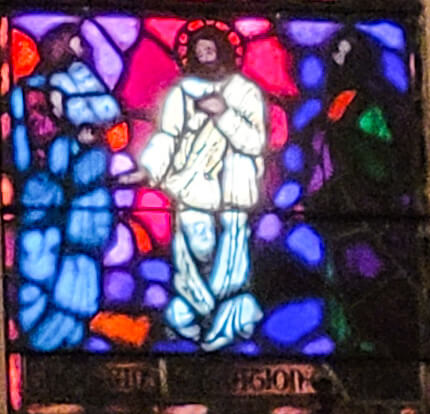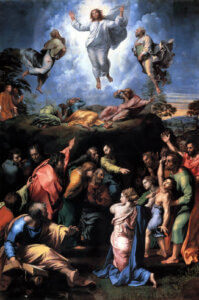
Transfigured Hearts
 Our liturgical seasons, they are a-changin’, to paraphrase the great contemporary theologian Bob Dylan. Today is Transfiguration Sunday, the last Sunday after the Epiphany, with Ash Wednesday coming up this week — on Valentine’s Day, to be precise. While most of us wouldn’t think of it right away, Transfiguration Sunday and Valentine’s Day may be more related than they seem. Even if you’re not a big giver or receiver of Valentines, most of us know the common emblem of Valentine’s Day: A heart shot through with an arrow.
Our liturgical seasons, they are a-changin’, to paraphrase the great contemporary theologian Bob Dylan. Today is Transfiguration Sunday, the last Sunday after the Epiphany, with Ash Wednesday coming up this week — on Valentine’s Day, to be precise. While most of us wouldn’t think of it right away, Transfiguration Sunday and Valentine’s Day may be more related than they seem. Even if you’re not a big giver or receiver of Valentines, most of us know the common emblem of Valentine’s Day: A heart shot through with an arrow.
That heart is not an anatomically correct representation of a human heart, and it doesn’t directly refer to the powerful muscle that controls our blood flow. Rambling around through the wiki-thickets, we learn that the symbol of a heart that we know comes from the shape of the leaves of a peepal tree, also known as a sacred fig. The shape came to represent the heart as a metaphorical center of human emotion, and particularly romantic love, as early as the Middle Ages. Enter Cupid, the god of desire, attraction and affection in classical mythology.
As early as Ancient Greece, Cupid’s super power was represented by a bow and arrow. A person, or even a deity, who is shot by Cupid’s arrow is filled with uncontrollable desire. The wiki-thickets also tell us that Cupids are a frequent motif of both Roman art and later classical Western art. By the 15th century, the iconography of Cupid starts to become indistinguishable from the cherub, and under Christian influence, Cupid the Cherub begins to represent both heavenly and earthly love in art and culture. Here’s the transfiguration part: those struck by Cupid’s arrow are suddenly filled with love for the next person they see.
Cupid’s bow and arrow are a metaphor for something that it’s really hard to describe or explain, but when a person’s heart is pierced by Cupid’s arrow, that person suddenly sees another person as beloved. It may be someone familiar, or someone never seen before, but Cupid’s bow and arrow symbolize the transformation of how we see another human being. That person is transfigured, and becomes the center of our world.
Theophanies
 Our lectionary today gives us two great moments of transfiguration, when we can see and feel God’s love. Theologians call these moments theophanies — those moments of clarity when God shows up, and there’s no doubt about it. In our first reading, from the Book of Kings, we catch up with the Prophet Elijah, and his protege and successor, Elisha. Elijah knows he’s close to death, and God has told him to go to Bethel. Elisha is loyal, dutiful, and probably more than a little scared. He continues to follow Elijah, even walking through the River Jordan after Elijah parts the river so that they can walk across on dry land. And then — we all know the hymn Swing low, sweet chariot, comin’ for to carry me home. And that’s what we see next! A chariot of fire and horses of fire rush between Elisha and Elijah, and Elijah ascends in a whirlwind into heaven.
Our lectionary today gives us two great moments of transfiguration, when we can see and feel God’s love. Theologians call these moments theophanies — those moments of clarity when God shows up, and there’s no doubt about it. In our first reading, from the Book of Kings, we catch up with the Prophet Elijah, and his protege and successor, Elisha. Elijah knows he’s close to death, and God has told him to go to Bethel. Elisha is loyal, dutiful, and probably more than a little scared. He continues to follow Elijah, even walking through the River Jordan after Elijah parts the river so that they can walk across on dry land. And then — we all know the hymn Swing low, sweet chariot, comin’ for to carry me home. And that’s what we see next! A chariot of fire and horses of fire rush between Elisha and Elijah, and Elijah ascends in a whirlwind into heaven.
North Carolina Methodist preacher James Howell writes,
We sing “Swing low, sweet chariot, comin’ for to carry me home,” although in all the annals of history we know of only one chariot that accompanied a homecoming. This chariot is beyond explanation — as the writer of 2 Kings surely meant it to be. A preacher’s job is to explain and clarify scripture, and how it applies to our lives today. But it’s easy to go too far, and to try too hard to explain the recorded and recollected experiences of our ancestors in the faith, and in doing that, strip away the nuance and power of mysteries, when the whole story is about a faith experience that is impossible to explain. I’m going to follow Elisha’s example here, and just point to his experience as we have it: God came very close, swinging down low and sweet into our lives. That experience transfigured Elijah, and ushered his protege Elisha — and us, looking on now — into the presence of the holy and living God. It shouldn’t surprise us that Elijah shows up in Jesus’ transfiguration experience from Mark’s gospel this morning, just to make God’s presence clear to Peter, James, and John — good Jews who knew the holy stories of the Prophets Elijah and Elisha well.
Mount Tabor
 The church remembers the site of Jesus’ transfiguration as Mount Tabor, a mountain in the middle of the lowlands near the Sea of Galilee. From the top, you can see for miles on a clear day, out over fields and vineyards and fishing boats on the Sea of Galilee. And as homiletics professor Tom Long tells us, things are supposed to look different from the mountaintop. That’s the whole point. One of the things we see is on the mountaintop is that Jesus is beloved by God. That would have been harder to see down in the everyday world in the vineyards, fishing boats, and synagogues below. Down there in the everyday world, we see that often Jesus’ disciples misunderstood him, he was rejected by his hometown, and the authorities were out to get him — trying to trip him up with tricky question and catch him out in his teaching.
The church remembers the site of Jesus’ transfiguration as Mount Tabor, a mountain in the middle of the lowlands near the Sea of Galilee. From the top, you can see for miles on a clear day, out over fields and vineyards and fishing boats on the Sea of Galilee. And as homiletics professor Tom Long tells us, things are supposed to look different from the mountaintop. That’s the whole point. One of the things we see is on the mountaintop is that Jesus is beloved by God. That would have been harder to see down in the everyday world in the vineyards, fishing boats, and synagogues below. Down there in the everyday world, we see that often Jesus’ disciples misunderstood him, he was rejected by his hometown, and the authorities were out to get him — trying to trip him up with tricky question and catch him out in his teaching.
Down off the mountaintop in the everyday world, it’s harder to see that Jesus was beloved by anybody. And from our vantage point today, we know how Jesus’ story unfolds, and that things are about to get worse. Jesus himself knows, and has told the disciples, that he “must undergo great suffering and be rejected.” Do we see Jesus as beloved at this point in the story? Not so much, really. But everything changes on top of Mount Tabor, when Jesus is transfigured before them, as Mark’s gospel tells us, his clothes dazzling white, such as no one on earth could bleach them.
 Peter is overwhelmed in the moment by the experience, as any of us would have been. He blurts out the first thing that crosses his mind, babbling about building houses for Jesus, Moses, and Elijah on the mountaintop, because, as Mark’s gospel tells us, they all were absolutely terrified, and Peter really didn’t have any idea what to say. Then a cloud overshadowed them, and from the cloud there came a voice,“This is my Son, the Beloved; listen to him!”
Peter is overwhelmed in the moment by the experience, as any of us would have been. He blurts out the first thing that crosses his mind, babbling about building houses for Jesus, Moses, and Elijah on the mountaintop, because, as Mark’s gospel tells us, they all were absolutely terrified, and Peter really didn’t have any idea what to say. Then a cloud overshadowed them, and from the cloud there came a voice,“This is my Son, the Beloved; listen to him!”
What does the transfiguration mean for us in our lives today? How would it change us, and how we live our lives if we could see ourselves in that dazzling light as beloved by God? Jesus’ ministry experienced rejection, failure and violence, and sometimes down in our own valley, we can feel discouraged, isolated, and a little lost.
But when we see Jesus beloved by God on that mountain, in clothes of dazzling white, can our hearts be transfigured by that moment of God coming down sweet and low in our lives? Can we see ourselves in Jesus’ light, see the cloud of God’s care hovering over over our heads, and hear God calling us “beloved”? Can that moment of mystery, that experience of God’s love and light transfigure our hearts, filling them with love, hope, and the courage to serve? That’s my prayer. Amen
